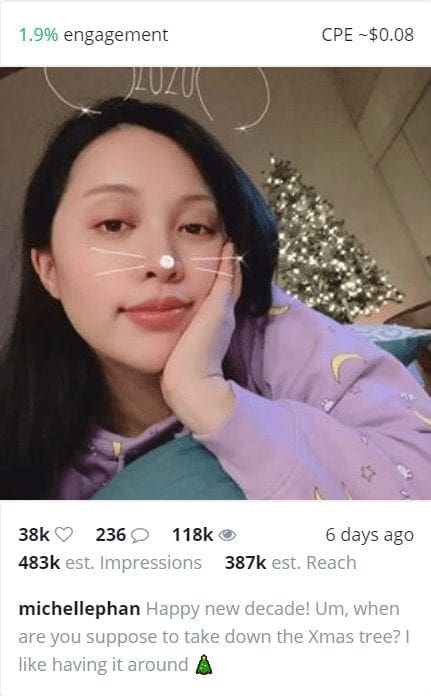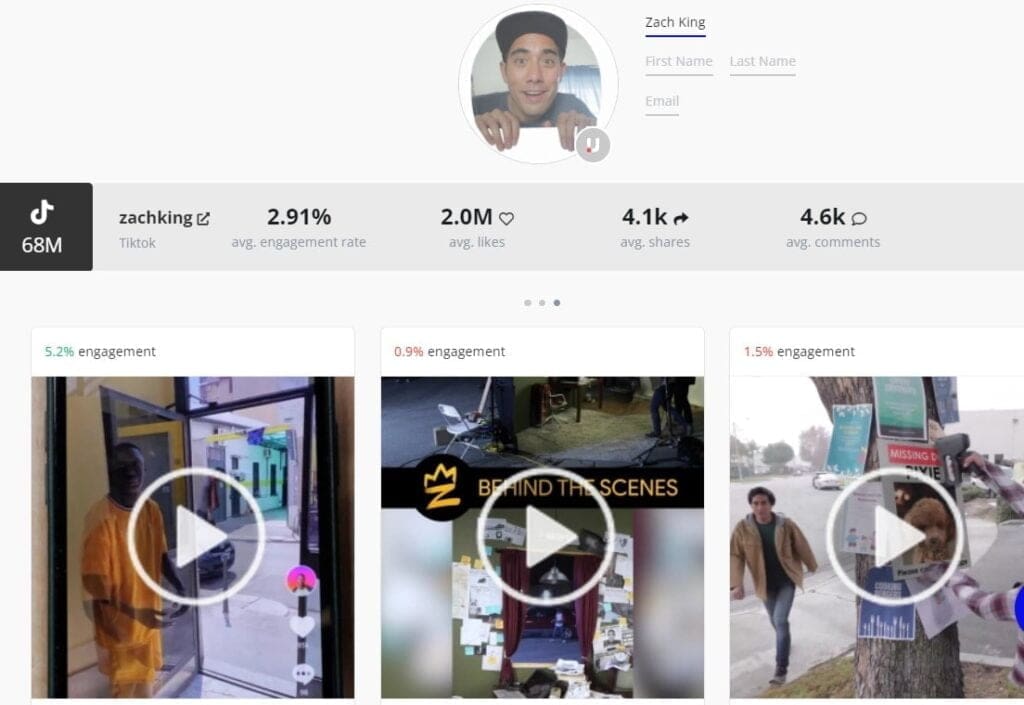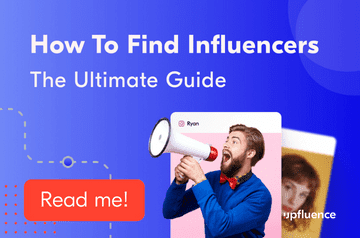Top influencer metrics to analyze before selecting an influencer:
- Follower count
- Estimated Reach
- Impressions
- Engagement Rate
- Fake followers
- Branded Content Frequency
Finding the best influencers to work with is like any recruitment process, you need to measure each profile against certain criteria needed for the job. When looking for influencers, your list might include things like industry niche, location, and performance metrics. If you find yourself with a list of hundreds of influencers that could be suitable for your campaign then you’ll need a way to find the absolute best match for your brand. That’s where these influencer metrics come in! Analyzing and understanding these key data points will help you build a better picture of the influencer’s performance and how effective they will be at driving results for your brand.
Number of Followers/Subscribers
The terms community or followers are straightforward enough – How many people follow an influencer? But there is a lot more about an influencer’s following size that marketers must know. Influencers are often categorized by the size of their audience, for example:
- Nano-influencers (1,000 – 5,000 followers)
- Micro-influencers (5,000 – 50K followers)
- Rising star influencers (50K – 500K followers)
- Macro-influencers (500K – 1M followers)
- Celebrity influencers (1M+ followers)
These categorizations will vary depending on who you ask, as the popularity of influencer marketing has allowed for new categories of influencer to emerge (such as the nano influencer) which were unheard of a few years ago. However, these categorizations according to the number of followers can serve as a useful guide to help you focus your influencer search on the category that is best suited to your campaign.
What you should know about follower sizes
In general, influencers with a large following charge more for their campaigns, only work with certain brands, or have extremely tight schedules. Needless to say, it’s competitive when brands want to work with mega influencers. (Remember when Kylie Jenner was offered $1.2M in exchange for an Instagram post?) In our blog post How Micro-Influencer Marketing Can Transform Your Business, you can learn more about why bigger isn’t always better when it comes to influencer following size.
This is why brands and marketers shouldn’t stop at an influencer’s following size. What other metrics can you consider to deeper understand an influencer’s impact more?

Reach vs. Impressions
Most people have some sort of understanding about reach and impressions, yet we’ve heard “What’s the difference between Reach and Impressions again?” more than you can ever imagine. But we don’t blame you, as sometimes the two terms can be confusing, especially when placed right next to each other. Here’s a quick-and-dirty rundown on the two terms, and whether you really need to pay attention to them.
Reach is the number of unique people who see your content. So, in a perfect world, if an influencer has 100 followers, they’ll have a reach of 100.
Impressions are the number of times that content has appeared on people’s feeds.
Oftentimes, the number of estimated impressions is higher than the number of estimated reach, simply because one person might see your content more than once. For example, if the content has been shown on 10 people’s feeds twice, the reach would be 10, and impressions would be 20.

What you should know about reach and impressions
Estimated reach and number of impressions are useful influencer metrics to look at when you want a quick snapshot of a creator’s general impact. However, it’s important to note that because impressions are calculated based on how many times your content has appeared on someone’s feed, it doesn’t guarantee the person has seen the content. For instance, they may close the app before scrolling all the way down to your content.
At the same time, reach and impressions are only the top layer of many other metrics you need to pay attention to. If 1,000 people have seen a post doesn’t necessarily mean there will be 1,000 engagements or conversions. When influencers have a high reach or high impressions it means they have the potential to help you build brand awareness and bring visibility to your brand. In order to make sure an influencer can drive real results for your brand i.e conversions, it’s worth digging deeper to look at engagement.
Engagement Rate
While reach and impressions are considered vanity influencer metrics, engagement rate reveals the true impact that an influencer’s content is having on their audience. Is their content provoking key actions such as likes, shares, and comments? You should look at their engagement rate to find out!
Engagement rate is: the number of average likes and comments an influencer receives compared to the total number of their followers. It is calculated like this: Total followers/Total engagements (over a certain time period) x 100.
Looking at engagement helps us to move out of the “How many people have seen my content” realm, and look at “How many of them are actually interacting with my content?”
An influencer’s engagement rate is the first prediction of how well your campaign might perform when you work with said influencer. As a brand, you need to be assured that your products are shown to a real and active audience. While reach can show the number of people who have seen the content, engagement rate shows a much more important picture: who is actually liking, commenting, showing interest, and potentially becoming real customers.
In fact, the number and quality of the comments is the most relevant indicator of real engagement. Likes and shares are a relatively quick way to endorse content, whereas comments require more effort.
What you should know about engagement rate
A standard influencer typically has an engagement rate between 1% – 3%, although smaller-sized and niche influencers tend to have a higher engagement rate (4% – 10%). This is demonstrated in the example below. If we compare the engagement rate of Zach King, a TikTok mega star with that of a beauty micro-influencer, we can see that having a larger online following can result in a lower engagement rate overall.

Zach King has an average engagement rate of 2.91% on TikTok.

Beauty micro-influencer @kitty_approved on the other hand has an engagement rate of 10.10% according to Upfluence data.
Micro-influencers tend to have a closer relationship with their followers. Just like how it would be easier for you to build a relationship with everyone in a smaller friend group, than in a giant room full of people. This is why smaller influencers’ engagement rates tend to be higher, more relevant to their content, and more similar to interactions between friends.

Fake Followers/Influencer Authenticity
It’s no secret that some influencers have ‘fake followers’ which help to inflate their follower numbers but ultimately damage their reputation. Looking at fake followers is one of the most important influencer metrics as it ensures your promotions are being seen by real users who can become real customers for your brand. The good news is there are effective tools to detect fake followers and influencers have become more cautious about inauthentic followers.
Upfluence has an influencer realness detection tool in its software which reveals what % of an influencer’s followers can be considered ‘real followers. But what red flags should you look out for influencer realness? Are influencers safe to work with only when they have 100% real followers? What about 90%? What can you do to double-check?
What you should know about fake followers
Upfluence detects inauthentic followers based on engaged followers, which are those who directly interact with influencers through likes and comments. So, an influencer with a 3% engagement, and 94% realness should be good to go. Note: It is possible for an influencer to never have bought fake followers to still have “spammy” comments sometimes due to their profiles being public, so anywhere above 90% realness is a positive indicator of an authentic audience.

Analyzing numbers can also be very telling. Does an influencer have 500k followers, but posts with only around 200 likes? (That’s 0.04% engagement rate. Yikes.) What about certain posts having significantly more likes than other posts? Inconsistencies in performance metrics are a strong sign of a fake audience, but this is only one of the many ways to detect fake followers.
Branded Content Frequency
Influencers are great – that’s why you are here. But there’s an important influencer metric to keep in mind, branded content frequency which can lead to “influencer fatigue.” This happens when consumers are exposed to too much branded content in an influencer’s feed. There are some influencers who are guilty of doing this, by having most – if not all – of their content dedicated to brand sponsorship. This leads to their social feeds being oversaturated with brand collaborations, and not enough organic posts to keep their audience engaged. A high branded content frequency is also referred to as a ‘saturation rate’, i.e what’s the rate of branded content vs. organic content in an influencer’s feed?
There are two reasons for brands to avoid working with influencers that have a very high saturation rate: not only will followers not trust the constant brand promotions (who can realistically praise 10 products in a day?), but your brand will get lost in a sea of branded content. Additionally, if an influencer constantly works with so many brands, how are you sure they didn’t or won’t work with your competitor as well?
What you should know about branded content frequency
You can identify sponsored content frequency by simply looking through an influencer’s feed. Not a fan of manual work? Upfluence also has a brand mention data collection that shows you how often an influencer mentions brands, which brands they mention, how many times they mention that brand, and how well those branded posts perform compared to their average engagement rate.
It’s rare to come across bigger influencers who have a low brand mention – and by that, we mean anywhere below 20%. (More reasons to work with micro-influencers!) But try your best to choose influencers with less than 50% – which means they mention a brand every other post. Nevertheless, the most important data to look at is how well those branded posts perform compared to non-sponsored posts. You’ll want an influencer whose effective percentage stays above 100%, meaning their branded posts perform just as well or better than other posts on their feed.

Now you have in-depth insight into the important influencer metrics you should be analyzing before working with an influencer. Taking the time to look at their performance, real audience %, saturation rate, and engagement rate will make sure you’re making a worthwhile investment in a partnership that will deliver results for your brand. Luckily, Upfluence’s influencer search tool displays all these essential influencer metrics for each influencer profile so you can save time when evaluating influencer profiles. What’s more, you can filter your influencer search according to follower number and engagement rate to discover the most relevant influencer profiles right from the start.
Get ready for your influencer search with more tips on understanding the different types of influencer, and how to choose the best ones for your brand in this guide:

























